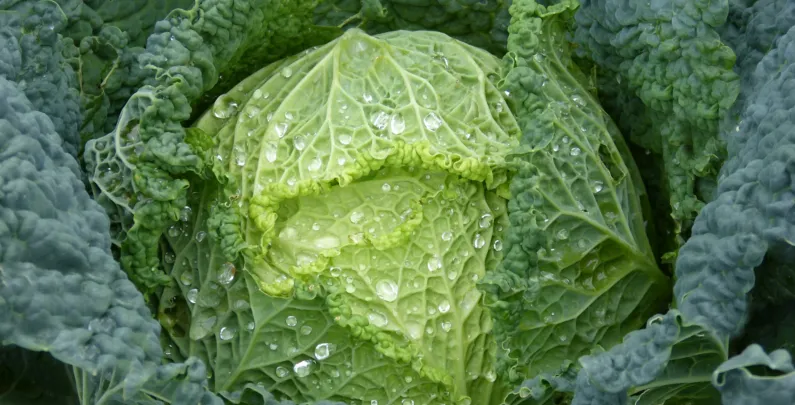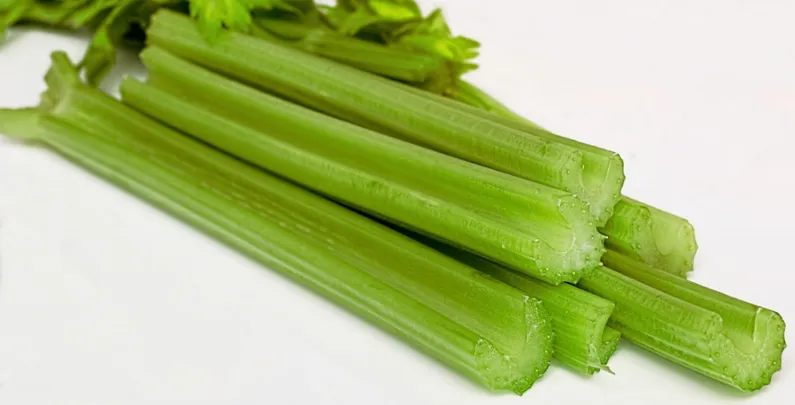Headed cabbage, or simply referred to as cabbage, is a cruciferous vegetable that is in the plant family Brassicaceae (also referred to as cruciferae) under the genus/species of Brassica oleracea, relating it closely to many common foods such as kale, broccoli, cauliflower, collards, kohlrabi, and brussel sprouts. Cabbage is further classified in the genus/species Brassica oleracea under the group capitata.
Cabbage is known to have been used as a food source for thousands of years but its exact origin is hard to determine due to how closely related it is with other cruciferous vegetables, with their many varieties worldwide. Many of these plants are shown to have originated from a type of wild cabbage that would have looked quite different from what we are used to seeing today. There is uncertainty about the time it was cultivated but it is believed that during Greek and Romans times it was a well-established garden vegetable. There is some evidence showing that about 4000 BC in China a type of cabbage was cultivated. The popular type of cabbage in the North American market is headed cabbage. Headed cabbage is believed to have been cultivated in Northern Europe sometime before 1000 BC and savoy and leaf cabbage (kale) cultivated in southern Europe.
Headed cabbage is known for its smooth folded leaves that create a multilayered head. The leaves of the plant are either green or red in colour. Green cabbages with a tight head of leaves are generally referred to as the subgroup alba, meaning “white” in Latin. The colours of green cabbage can range from a very light green, sometimes referred to as white cabbage, to a dark green. Red cabbage have a dark red or more purple colour with some very dark varieties sometimes referred to as black cabbage. This colour of cabbage are classified under the subgroup rubra, meaning “red.” Red cabbage can have other variations in colours depending on the soils where it’s grown and its pH value. This is due to a anthocyanin called flavin, which gives red cabbage its colour, reacting to the pH values in the soil. Red cabbage juice due to the flavin anthocyanin can be used as a pH indicator. The outer leaves are the richest and most intense in colour with inside leaves being lighter due to lack of sunlight being able to reach them. Other cabbages fall under separate subgroups depending on the specific characteristics head, such as the type of leaves or how densely compact they are.
Like all the cruciferous vegetables, cabbage provides many health benefits. Research has identified nearly 20 different flavonoids and 15 different phenols present in cabbage, all of which have shown antioxidant activity. There is a special interest in red cabbage due to its anthocyanins; in particular a subcategory of anthocyanins called cyanidin that are antioxidants and provide anti-inflammatory benefits. The anthocyanins in red cabbage play a major role in the vegetable’s ability to provide cardiovascular protection such as the protection of the body’s red blood cells. Intake of red cabbage has been shown to improve blood levels of beta-carotene, lutein, and the blood’s total antioxidant capacity, along with the ability to lower the levels of oxidized LDL (“bad” cholesterol). While red cabbage does provide its own unique antioxidant benefits, even green cabbage possesses a significant amount. It is due to cabbage’s antioxidant content that provide it with many of its anti-cancer properties. If the body has an inadequate amount of antioxidants it can compromise our oxygen metabolic system, leading to oxidative stress. This chronic oxidative stress can then lead to the development of cancer.
There are also many other components of cabbage that have anti-cancer benefits as it is a good source of sinigrin, a sulfur containing glucosinolate. The release of sinigrin when eaten can cause it to change into allyl-isothiocyanate (AITC), a type of compound that has been shown to have anticancer properties. Glucobrassicin is another glucosinolate that can be converted into the compound indole-3-carbinol (I3C) and further into diindolylmethane (DIM). Diindolylmethane is a compound that is derived from indole-3-carbinol in the stomach with sufficient acidic. The three compounds allyl-isothiocyanate, indole-3-carbinol, and diindolylmethane have shown particular anti-cancer properties for bladder, colon, and prostate cancer, but have benefits for other types of cancer as well. These isothiocyanate compounds help with cancer prevention in a number of ways. They help to regulate the inflammatory response in our system by altering the activity of the inflammatory system’s messaging molecules and help with detoxifying our bodies resulting in smaller toxic loads on our cells.
Cabbage is rich in a variety of vitamins and minerals, with red and green cabbage containing different amounts. Green cabbage is high in vitamin content with per 100 grams having 36.6 mg of vitamin C, 76 mcg of vitamin K, and 43 mcg of folate. It contains good amount of vitamin B6 with 0.1 mg, thiamin (vitamin B1) 0.1 mg and choline 10.7 mg. Red cabbage contains a high amount of vitamin A with 1116 IU, 57 mg of vitamin C, 38.2 mcg (microgram) of vitamin K, and 0.2 mg of vitamin B6. IU, or International Unit, is a unit of measurement used to measure the biological activity, rather than weight, of fat soluble vitamins, such as vitamins A, E, and D.
Cabbage has good amount of the vitamin thiamin (B1) with 0.1 mg, riboflavin with 0.1 mg, folate with 18 mcg, and 17.1 mg of choline. In mineral content, green cabbage has good amount of calcium (35.6 mg), magnesium (10.7 mg), potassium (151 mg), and manganese (0.1 mg). Red cabbage in high in manganese with 0.2 mg and contains a good amount of calcium with 45 mg, iron with 0.8 mg, magnesium with 16 mg, and 243 mg of potassium with 243 mg.
Other important nutrients in green cabbage are fibre (2.5 g), protein (1.3 g), and very little carbohydrates with a counted carbohydrate amount of only 3.3. Red cabbage contains 2.1 grams of fibre, 1.4 g of protein, and 5.3 g of counted carbohydrates. Cabbage is a source of water as the bulk of its weight is in water content with green consisting of 92.18 g and red consisting of 90.4 g of water per 100 grams of cabbage.
The good amount of mineral content present in cabbage makes it a good source of food for bone health. The minerals calcium, magnesium, and manganese along with others are used in the creation of strong bone density, growth, and development. Vitamin A, which red cabbage is a good source of, provides a large variety of health benefits. This includes skin health with improved elasticity of the skin, the regrowth of skin cells, and protection from sun damage. Vitamin A also helps with eye health by preventing macular degeneration and the formation of cataracts. It is so important to eye function that we would be blind without it.
Cabbage is used in the creation of sauerkraut. Sauerkraut is the process of fermenting cabbage by mixing it with salt and leaving it in its own liquid. This process provides plenty of health benefits. It increases the bioavailability of nutrients that are present in cabbage and provides a source of good bacteria for our bodies. These good bacteria help with digestion, colon health, intestinal health, and in preventing ulcers, helping to balance ph, and preventing cancer, along with many more benefits. The process of fermenting cabbage into sauerkraut was considered a vitally important source of nutrients for sailors to prevent scurvy and for the winter months when there was no source of readily available fruits and vegetables. What also made sauerkraut important is that it had a long storage life span lasting for months, making it possible for long trips without nutritional deficiency complications.
Cabbage along with others in the genus Brassica are considered goitrogenic food. Goitrogen refers to substances that affect the thyroid gland, making it unable to absorb its needed iodine amount. This causes the release of thyroid-stimulating hormone (TSH) that allows the thyroid to grow. This growth is done to give the thyroid a wider absorption range, but can lead to a condition called goiter. Cabbage along with some other foods can prevent the thyroid from absorbing iodine. The amount that they interfere is relatively little and a significant amount would have to be eaten to have an effect for a healthy individual. Cabbage and other vegetables that could cause goitrogens provide much health benefits to the body, including the thyroid. They provide nutrients for the thyroid that allow it to function properly and prevent other conditions such as thyroid cancer. The main cause of goiter is a lack of iodine in a person’s diet. This is why it is important to have a balanced meal that includes all the nutrients that the body needs.
When purchasing cabbage there are a few things to look out for. The leaves should be packed tightly together with only a few missing outer leaves. It should be firm and crisp with a rich colour. The exact colour depends on the variety purchased. The leaves should be free of any bad spots such as bruising, browning, or any other aspect that would seem off. To clean cabbage the outer leaves should be removed. Then a person can either clean each of the outer leaves individually or they can cut it into quarters and wash in cold water. When cutting into quarters be watchful for any dirt or insects that can be present. If any are seen, or just to make certain, the quartered cabbage can be soaked in a wash of water and distilled white vinegar, usually consisting of three part water with 1 part vinegar, for 20 minutes. Then rinse the cabbage to remove the vinegar and any loose pieces of dirt. It is best to wash cabbage just before use to prevent vitamin C loss. Vitamin C reacts with light and air, causing it to degrade. The phytonutrients in cabbage react with carbon steel and turn the cabbage black. It is best to use cutlery that is stainless steel so this reaction does not occur. Vitamin C also breaks down with heat. This means that some of the vitamin C content in C in cabbage is lost during cooking, such as when making stir fries or soups. This does not mean that cabbage can only be eaten raw. It just means that the raw form provides the more optimal nutritional content for cabbage. Fermented cabbage (sauerkraut), still provides plenty of vitamin C content.
Lightly steamed cabbage, about 7 minutes or less, does provide a boost to certain nutrients in cabbage. It boosts the concentration of allyl-isothiocyanate (AITC). Using a microwave to heat or cook cabbage, or any food, should be avoided as it destroys nutritional content in a short period of time. Merely 2 minutes of microwaving cabbage destroys more nutrients than when cooking on the stove. Cabbage is a versatile vegetable for meal use. It can be used to make soups, eaten raw, used in salads or sandwiches, fermented, and added to stir fries, along with many other creative ways of consumption. This versatility is one of the reasons that cabbage has been popular throughout the years.
Cabbage provides many benefits for a healthy lifestyle. It contains many essential vitamins and minerals such as calcium, vitamin C, vitamin K, manganese and red cabbage and high amounts of vitamin A. It provides plenty of antioxidants due to its flavonoids and phenols and is rich in glucosinolate that provides many benefits including anti-cancer properties. Cabbage is low in carbohydrates making it easy for people that need to watch their carbohydrate consumption to enjoy its benefits. Cabbage is a wonderful vegetable that provides plenty of nutritional and health benefits when incorporated into a person’s diet.


